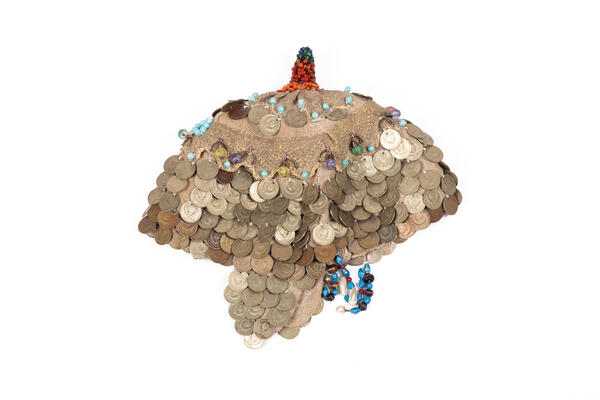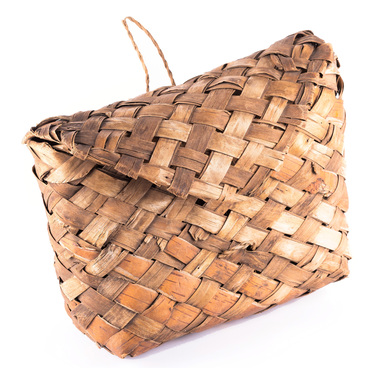The traditional Chuvash headdress tukhya was an item in the wardrobe of unmarried girls. A deep, hemispherical hat, made on a dense foundation and embroidered with beads, it covers the entire forehead down to the eyebrows, and seemingly duplicates the head’s rounded outlines, with only its high tip (like a spiked helmet, and called a shishak) standing out. It was customary to hang the most expensive coins on a tukhya: silver rubles and fifty-cent pieces. Beaded pendants with small coins at the ends hanging on the sides of the tukhya helped to highlight the shape of the face. Rounded neck ornaments played the same role down below that.
The Chuvash tukhya symbolizes different levels of the universe, so the beaded jewelry at the very top of the tukhya usually contains signs that represent the sun. The headdress is, as it were, divided into three parts: the lower level of coins, the middle level of beads, and the highest level where the shishak is. Beads were used that only had warm colors — red, yellow, and white. Chuvash living in upper regions on the Volga River made tukhyas without a shishak, and green and light blue beads were also used in the ornamentation. The latter symbolizes the celestial sphere.
The beaded geometric ornamentation has direct equivalents in the patterns used in traditional Chuvash embroidery — these are rhombus-shaped figures, oblique crosses with bent ends. The most expressive of these were the patterns on the tukhyas made by the Chuvash living in lower regions along the Volga River: they weaved decoration in the form of a curved ribbon that was 4 cm wide, and then sewed that onto the hat. Small decorative items also played a certain role in enriching the artistic image of the ornamentation and headdresses: in combination with rhythmic, colored stripes, they were used to decorate borders and put around the edges. The main techniques used in decorating were to let something freely dangle or to sew it on.
According to Chuvash tradition, the bulk of the items that were used for decorative purposes was made at home. Only truly intricate products were ordered from rural craftsmen that specialized in a particular craft. Only local materials were used to make the foundation for decorative items. This is probably due to the fact that Chuvash decorative items and headdresses reinforced the special clan and social status that their owners had. For example, in the attire worn by a mature woman, coins were mainly used as decor, and beading and weaving predominated in the attire worn by young girls.
The Chuvash tukhya symbolizes different levels of the universe, so the beaded jewelry at the very top of the tukhya usually contains signs that represent the sun. The headdress is, as it were, divided into three parts: the lower level of coins, the middle level of beads, and the highest level where the shishak is. Beads were used that only had warm colors — red, yellow, and white. Chuvash living in upper regions on the Volga River made tukhyas without a shishak, and green and light blue beads were also used in the ornamentation. The latter symbolizes the celestial sphere.
The beaded geometric ornamentation has direct equivalents in the patterns used in traditional Chuvash embroidery — these are rhombus-shaped figures, oblique crosses with bent ends. The most expressive of these were the patterns on the tukhyas made by the Chuvash living in lower regions along the Volga River: they weaved decoration in the form of a curved ribbon that was 4 cm wide, and then sewed that onto the hat. Small decorative items also played a certain role in enriching the artistic image of the ornamentation and headdresses: in combination with rhythmic, colored stripes, they were used to decorate borders and put around the edges. The main techniques used in decorating were to let something freely dangle or to sew it on.
According to Chuvash tradition, the bulk of the items that were used for decorative purposes was made at home. Only truly intricate products were ordered from rural craftsmen that specialized in a particular craft. Only local materials were used to make the foundation for decorative items. This is probably due to the fact that Chuvash decorative items and headdresses reinforced the special clan and social status that their owners had. For example, in the attire worn by a mature woman, coins were mainly used as decor, and beading and weaving predominated in the attire worn by young girls.



